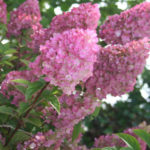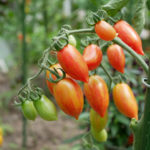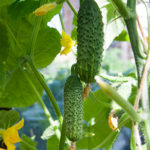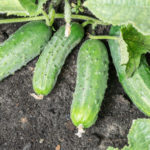Thuja western Yellow Ribbon
In landscape design, a wide variety of conifers are used. Thuja is especially popular. The most valuable variety for decorating a garden and a personal plot is Yellow Ribbon (Thuja occidentalis Yellow ribbon), which is due to the extraordinary attractiveness of the needles and the shape of the evergreen.
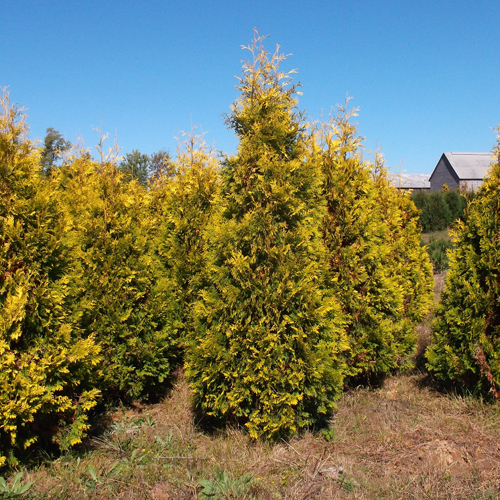
History of creation and description of the variety
It is one of the many forms of white cedar, whose natural distribution area covers the North American continent. This variety can be called the brightest representative of the Cypress family, and in the truest sense of the word. The fact is that a distinctive feature of the culture is the unusual yellowish-golden hue of young needles, which looks most juicy in sunny weather. For this reason, the culture was named Yellow Ribbon, which in English means “yellow ribbon”. Indeed, young needles, formed on the shoots protruding above the surface of the crown, fall from the top of the plant downwards in peculiar, smoothly curving ribbons. Due to this, the tree looks very impressive. In addition to the incomparable coloring, the needles of our heroine are equipped with a glossy sheen. In addition, it is large, dense, with a relief surface, with all its appearance resembles the scales of a golden dragon. However, the thuja needles are soft to the touch.
The plant itself has the shape of a narrow cone and is characterized by an average growth rate. Every year, the size of the Yellow Ribbon increases: in width - by 8 cm, in height - by a maximum of 15 cm. The American beauty becomes a full-fledged tree about 15 years after planting. At this age, it reaches a height of about 2 meters, expanding to 150 cm in width.
The root system of the variety is branched and shallow. Young shoots are wide and flat, growing mostly vertically, old ones are green, as if covered with a noble patina. In the fall, a spectacular ephedra acquires small brown cones, adding decorativeness to its appearance.
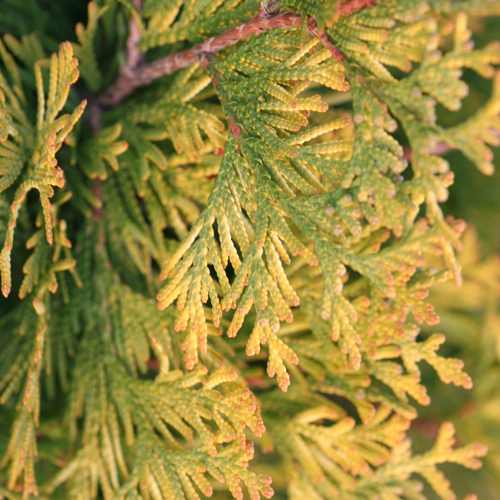
A drop in air temperature in winter does not spoil the luxurious beauty of golden thuja. From frost, its needles do not fade, but, on the contrary, shine more than before, acquiring an orange-brownish-yellow tint. This plant looks especially beautiful when there is snow around it. Therefore, many owners of the variety use it as a living Christmas or New Year tree instead of the usual spruce.
Yellow Ribbon is a fairly winter-hardy crop. It can withstand frosts below -30ºC without any problems. Also, the variety is highly resistant to insect pests and diseases. Golden ephedra can be cultivated in urban conditions, since harmful impurities present in the air have little effect on it in a negative way. The plant can react negatively to sudden temperature changes, and at a young age it can suffer from sunburn.
Features of agricultural technology
Tuyu must be placed in a sector of the site where there is a lot of sunlight. This is important, because when the culture is in the shade for a long time, its needles lose their decorative golden color and can even thin out. The plant must also be protected from gusty winds. The best growth and development of a crop is ensured by its cultivation on fertile, light, loose and moderately moist soils. Heavy loamy soil is categorically unsuitable for ephedra. The optimum acidity of the soil used for planting the plant: pH 4.5-6. Recommended thickness of the drainage layer: 10-20 cm. The soil mixture for planting ephedra can be made up of 2 parts of turf, 1 part of sand and the same amount of peat.
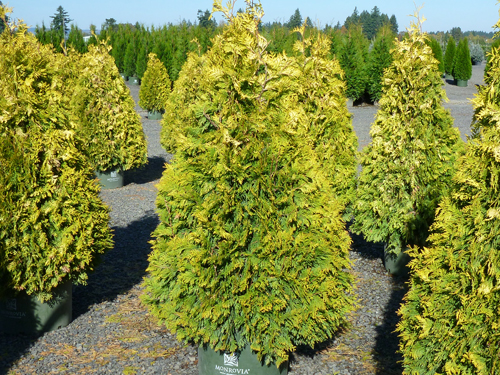
The western thuja variety we are considering is moisture-loving. Drying out of the soil under the tree often leads to a thinning of the crown. In dry summers, the crop needs to be watered often and abundantly, as well as sprinkling. A day after moistening the soil under Ellow, the ribbon is loosened to a depth of no more than 8 cm. Next, the substrate is mulched with chips or peat.At the time of planting, 500 grams of nitroammophoska is added to the soil. Then, every spring, the culture is fed with a complex fertilizer such as "Kemira-Universal". And at the beginning of the autumn period, the ephedra is treated with phosphorus-potassium concentrate. But do not overfeed the plant, otherwise it will lose its attractiveness due to too rapid growth.
Ephedra is pruned annually in the spring. In the process of this event, dry shoots are removed. In addition, if there is such a need, a shaping haircut of the thuja crown is carried out. It should be moderate, that is, the shoots are shortened by no more than 1/3 of their main length. In the year of planting, it is advisable to cover the plant for the winter. For this purpose, it is wrapped in burlap or other textile insulation. Such a measure will serve as good protection against spring and winter sunburn.
In the absence of proper care and in adverse weather conditions, the culture can be attacked by false shields and thuja aphids. The plant can be protected from their appearance by performing preventive spraying with an insecticide solution several times per season.
Use cases
Yellow Ribbon can be used to create group compositions and act as a tapeworm on a grassy bright green lawn. However, first of all, it is intended for decoration of coniferous alleys and living evergreen hedges - both free-growing and clipped. The orange-yellow coniferous wall created with the help of thuja of the specified variety looks unusually beautiful. The golden beauty goes well with other conifers. It is also included in woody and shrub compositions. Landscape designers successfully use this plant for landscaping boulevards, squares, recreation areas, school yards, city squares and parks, territories at medical and educational institutions.
